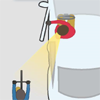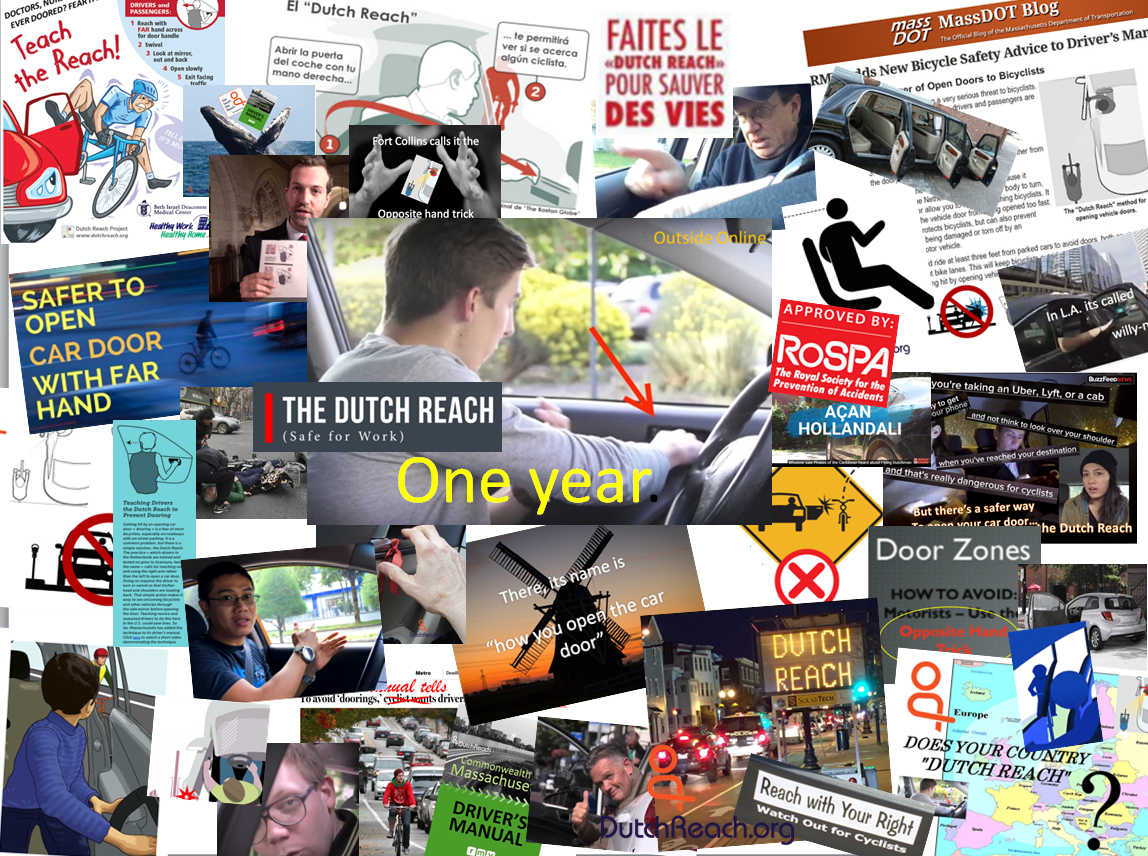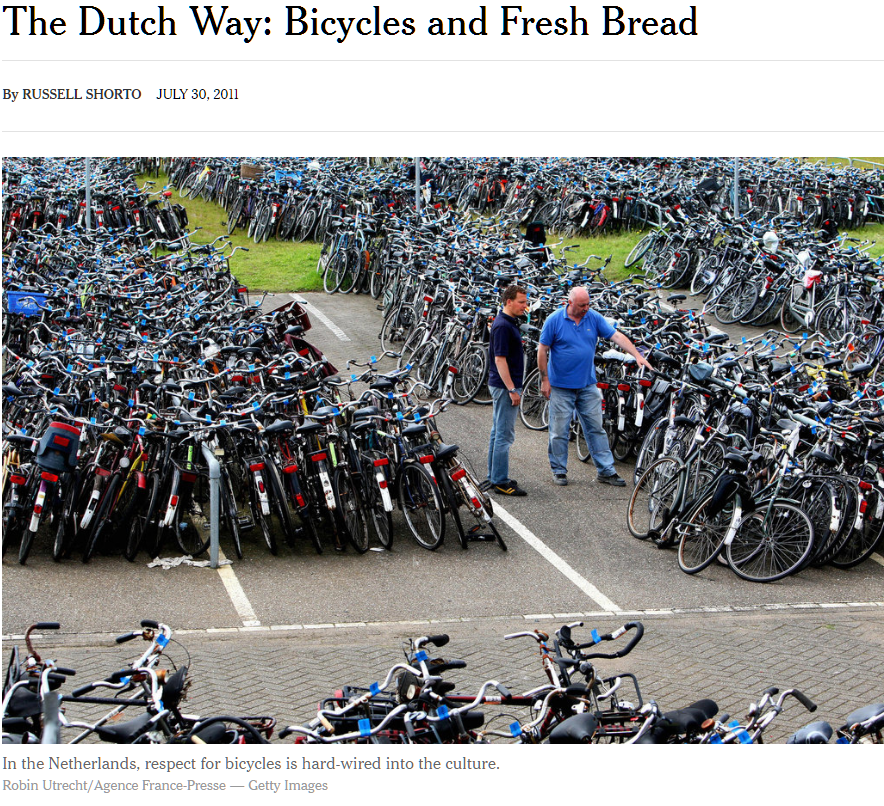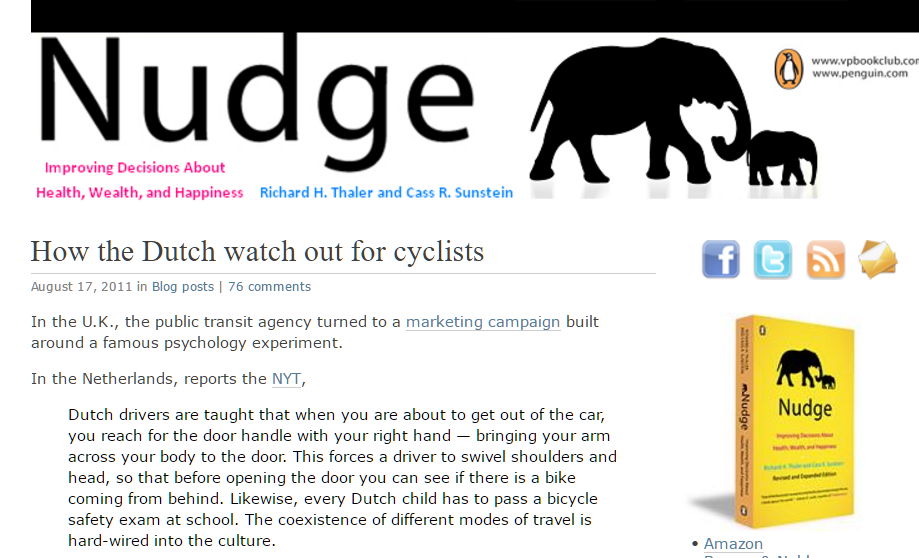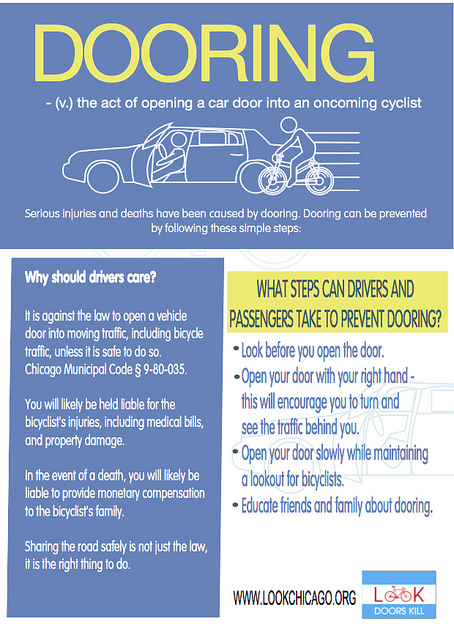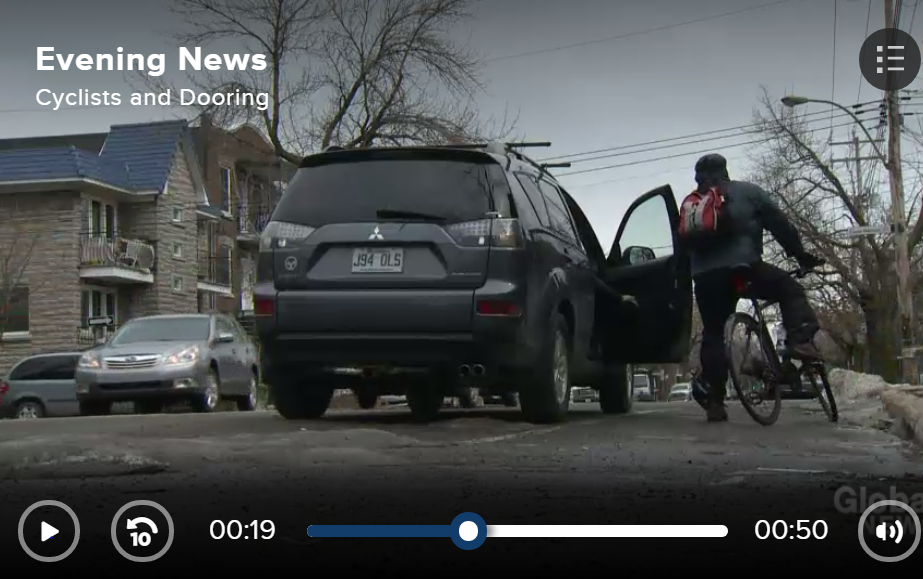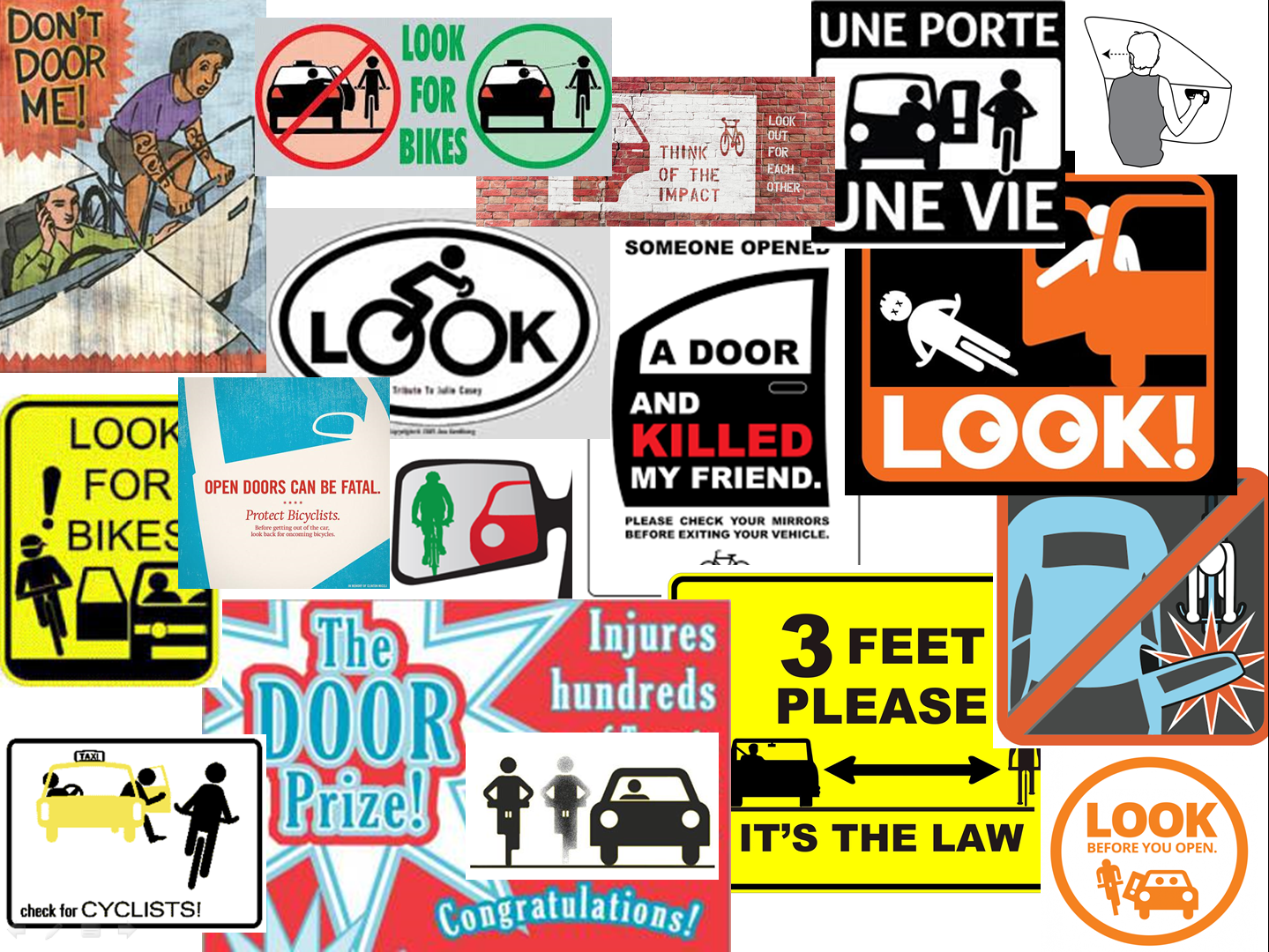
Montage of anti- dooring graphics - stickers, posters & logos from around the world, pre-'Dutch Reach' campaign. Find source files here. Click image to enlarge.
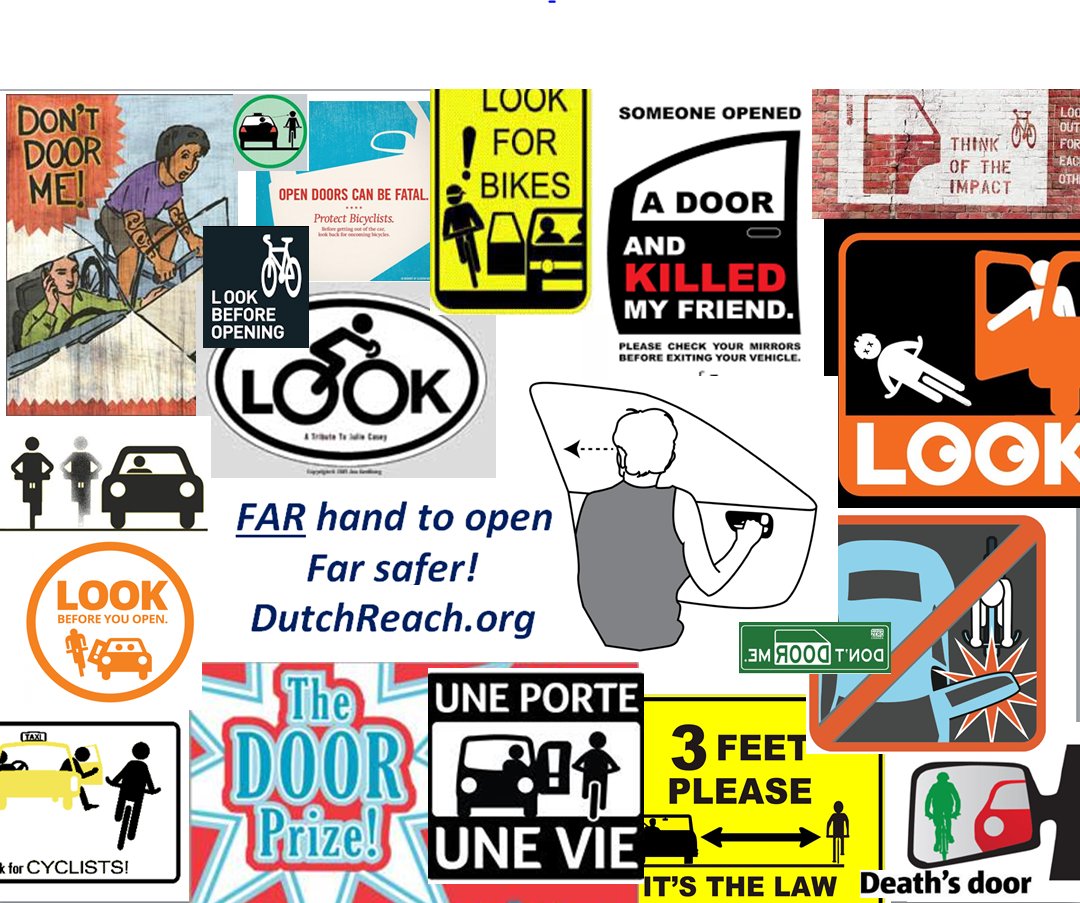
Montage is assembled with pre-2016 stop dooring campaigns from around the globe. Most called for drivers to LOOK! The Dutch Reach makes looking a habit. Find source files here. Click image to enlarge
For a annotated summary article on the Dutch Reach, see the "Dutch Reach" entry under "Dooring" in Wikipedia,
PRIOR REPORTS OF REACH METHOD OUTSIDE EUROPE*
The Dutch advanced the far hand method as a commonsense best practice over fifty years ago to prevent doorings. [For documentation of its recognition & practice in The Netherlands, see: Is the ‘Reach’ Method Really Dutch?]
Its popularization was likely a product of the Stop de Kindermoord (Stop the Child Murder) parent protest movement fighting Holland's vast traffic carnage of the early 1970's.
The technique is still often taught in NL, though its use is longer as widespread nor as needed. For the Netherlands is now one of the safest places to walk, bike or drive. Currently, 40% of the Dutch use bicycles. Furthemore their entire road sharing culture and infrastructure is now very advanced -- and always getting better. Even so, the far hand is still favored as the safest grip when exiting, and has for decades been the gold standard practice for passing The Netherland's famously strict licensing road test.
Elsewhere in Europe -- likely for decades as well -- the far hand reach has also been practiced, though of unknown duration and extent. It seems to be or have been known in Denmark, Sweden and Belgium, and to a lesser extent in France and Germany. A 1950's graphic - apparently from the U.K. - suggests use of the far hand to do a shoulder check, but documentation is lacking. [View graphic here or at bottom below.] Whether any of these countries recommended or promoted its use officially, and whether it spread from NL or was independently recognized, is obscure - at least to this author. [Informed knowledge on these questions is most welcome! If you know better, please Contact us!]
Its use, awareness of, or promotion of the method beyond mainland Europe prior to 2011 is also as yet unknown to this Project.
This decade however cities and/or advocacy groups in Chicago, IL; San Francisco, CA; New Haven, CT; Fort Collins, CO; Montreal QC & Vancouver BC, Canada began introducing it via official channels and/or safety campaigns. The City of Melbourne Australia engaged in several dooring studies starting around 2010 & later its state transportation agency VicRoads modestly promoted the far hand method as a countermeasure to dooring in a tip sheet to drivers. Earlier this century, Toronto cyclist and writer Lloyd Alter wrote columns endorsing the method as Toronto was and remains plagued by doorings, so much so as to found a campaign against getting The Door Prize, and started a registry of dooring fatalities which sadly continues to this day, and which is now maintained by John Brooking of Portland, ME, USA [view it here].
Awareness of this 'Dutch', 'Amsterdam', 'Danish', 'European' or 'European city' method seems only to have arrived in North America and Australia in the last decade. The earliest US main stream press reports are from the New York Times in 2011 and the Boston Globe, 2013. Anecdotal reports have it that the police department of Bullhead, AZ taught the method to its officers starting decades ago, and that travelers to Sweden from Northampton, MA, USA learned of it perhaps 20 years ago as well.
This list is likely incomplete, but it appears safe to say that few if any municipal governments or cycling advocacy groups beyond the shores of several European nations, knew of, taught, or promoted the far hand method to any notable extent until the 2010s.
For more on these and other pre-Dutch Reach Project anti-dooring efforts, see: Anti-dooring Campaigns.
'Dutch Reach' name - 1st print appearance
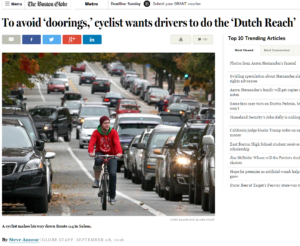
To avoid 'doorings'... by Steve Annear, Boston Globe, 8 Sept 2016
For documentation of the Far Hand Method's introduction & practice in The Netherlands, see: Is the ‘Reach’ Method Really Dutch?
THE FAR HAND METHOD SINCE ~ 2010
2011 - THE DUTCH WAY: BICYCLES AND FRESH BREAD
by Russell Shorto, New York Times, July 30, 2011.
“To give a small but telling example, pointed out to me by my friend Ruth Oldenziel, an expert on the history of technology at Eindhoven University, Dutch drivers are taught that when you are about to get out of the car, you reach for the door handle with your right hand — bringing your arm across your body to the door. This forces a driver to swivel shoulders and head, so that before opening the door you can see if there is a bike coming from behind. Likewise, every Dutch child has to pass a bicycle safety exam at school. The coexistence of different modes of travel is hard-wired into the culture.”
2011 - NUDGE BLOG CITES SHORTO, NYT
HOW THE DUTCH WATCH OUT FOR CYCLISTS
This August 17, 2011 Nudge Blog post was, prior to September 8, 2016, perhaps the only easily referenced webpage in English dedicated to the Reach. Together with its original source, the July 30, 2011 article in the NYTs above, they are the earliest documentation thus far found by or reported to this Project, of the far hand Reach method in English on the web:
"In the U.K., the public transit agency turned to a marketing campaign built around a famous psychology experiment. In the Netherlands, reports the NYT* Dutch drivers [& passengers] are taught that when you are about to get out of the car, you reach for the door handle with your [opposite] hand, bringing your arm across your body to the door. This forces a driver [& passengers] to swivel shoulders and head, so that before opening the door you can see if there is a bike coming from behind. Likewise, every Dutch child has to pass a bicycle safety exam at school. The coexistence of different modes of travel is hard-wired into the culture."
The then editor of the Nudge Blog, John Balz cited it as an exemplary nudge. A nudge is a small change - often a shift to a new default action - which has larger societal and individual benefit. The Dutch method prevents crashes by simply swapping one habit for another. The blog - which is now inactive - promotes the book Nudge - Improving Decisions about Health, Wealth & Happiness by Richard Thaler & Cass Sunstein.[who, by the way, have each when contacted, disclaimed any knowledge of this Nudge Blog post nor of the Dutch method. - ed.]
Tips for Drivers & Passengers 2012
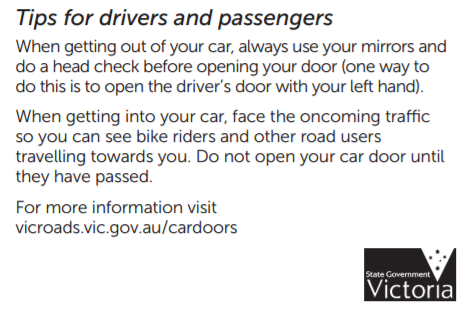
VicRoads Tips on dooring prevention tells Australia's drivers to use their left (ie. far hand in AU) to open & exit - part of the State of Victoria's anti- car dooring campaign. Click image to enlarge. Most recent update version here.
2012 - VicRoads warns drivers on dooring
Advice for drivers [now updated here]
[2012 Advisory]:
Bike riders are legitimate road users, and are therefore entitled to use the road just the same as any other road user. Car drivers and bike riders should share the road safely and look out for each other.
Get into the habit of always using your mirrors and doing a head check before opening your car door (one way to do this is to open the car door with your left hand) [Emphasis added - ed.]
Bike riders can travel quickly and may be much closer than you think
When getting into your car, face the oncoming traffic so you can see bike riders (and other road users) travelling towards you. Do not open your car door until they have passed.
Bike riders can ride between parked cars and the lane of traffic so, as a passenger, do not get out of a stationary car when in moving traffic.
Check out the following animation Checking for cyclists and motorcyclists [Video](External link) for further information about how to be more aware of cyclists when opening your car door.
Share the road safely.
Note: In the above VicRoads advisory, the 2015 video recommends motorists check mirrors and do a 'head check', but the far hand method and its advantages as a replacement habit is not given despite its recognition at the very outset of the advisory's text.
2012 - ARTICLE in THE CONVERSATION - from Australia
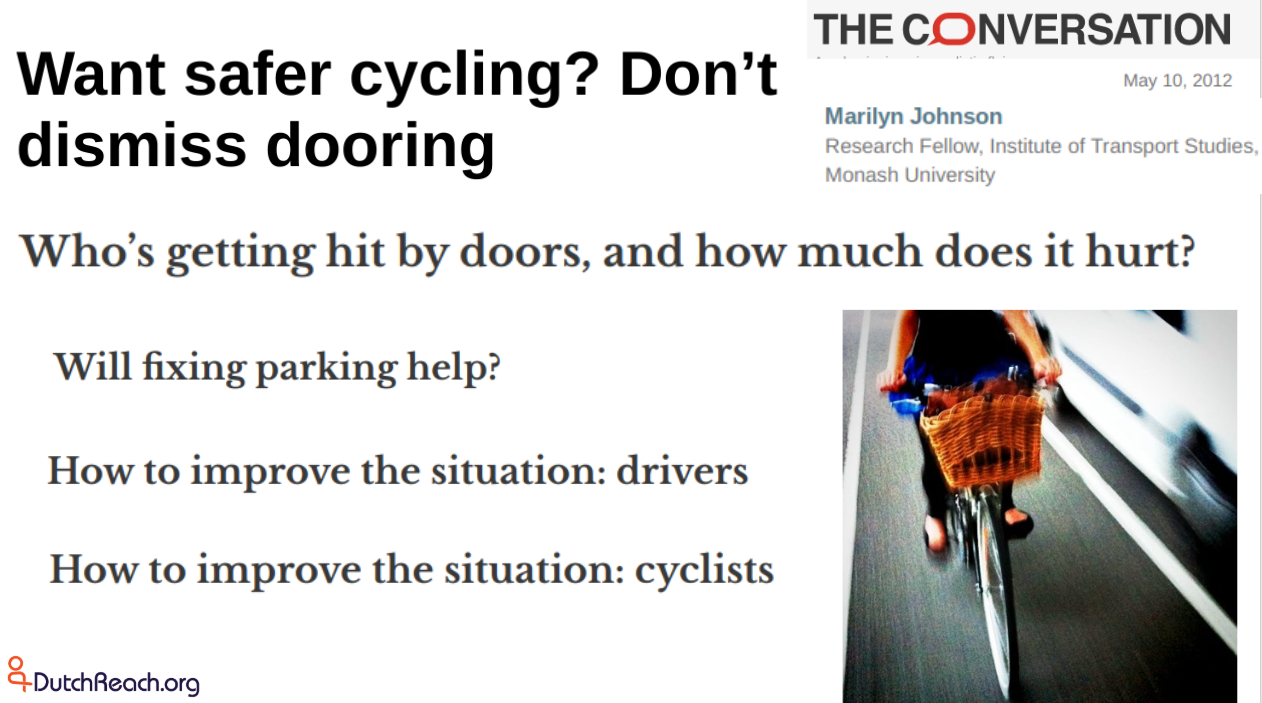
Want safer cycling? Don’t dismiss dooring, by Transport Researcher Marilyn Johnson, The Conversation, May 10, 2012. A clear overview of Dooring issues: causes, incidence, consequence, solutions which included far hand method - from Australia (where one drives on the left)
2013 - CHICAGO 'LOOK' CAMPAIGN with 'REACH' TEXT
“Look Chicago” Anti-Dooring Campaign Starts Flyering on Saturday, Streets Blog Chicago, Feb 28, 2013.
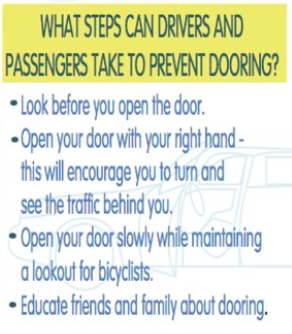
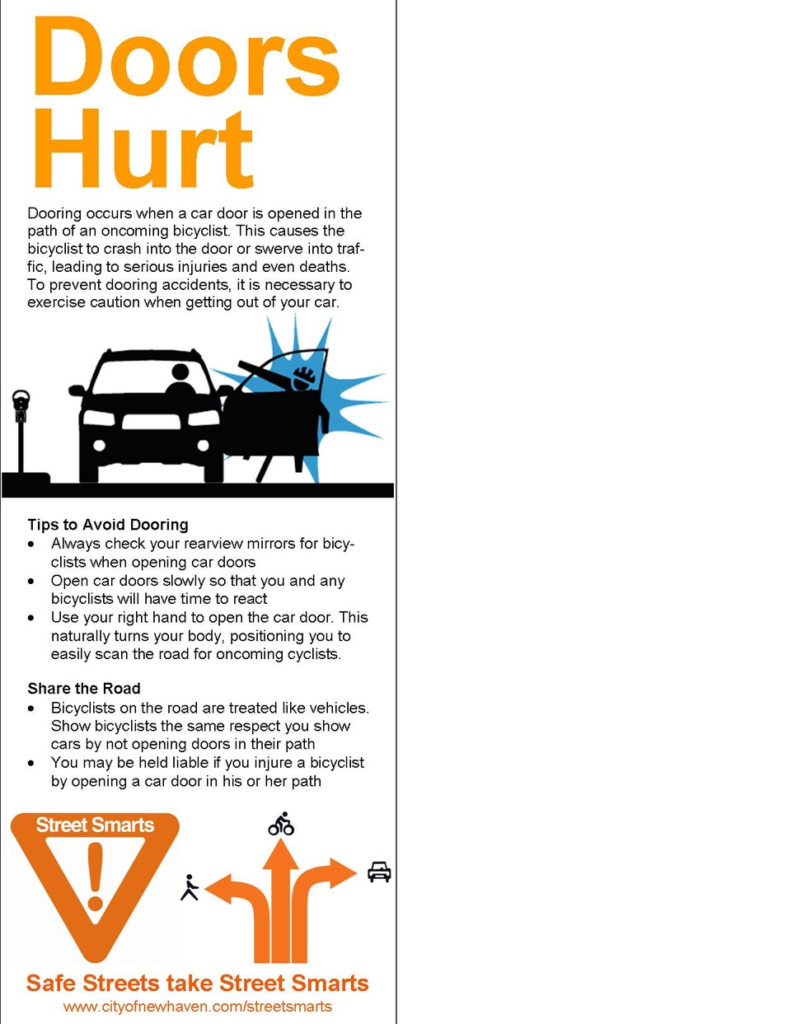
"Doors Hurt" flier produced by the City of New Haven, CT, USA Dept of Transportation, Traffic & Parking for its 2013 anti- dooring campaign. "Doors Hurt" advises drivers to use their right hand to open car door but to enable swiveling to look back for cyclists. But the campaign did not use a unique name to describe it. (A contemporary news story in the New Haven Independent descibed the maneuver as the "Amsterdam Method." Even so, the effort anticipated the Dutch Reach campaign by three years.
2013 - NEW HAVEN, CONNECTICUT, USA: "DOORS HURT"
New Haven campaigned for drivers to use the "Amsterdam method"
In 2013, the New Haven's Transportation, Traffic & Parking Dept. promoted "the new Amsterdam technique" ie. 'reach across' -- and other advice to reduce cyclist doorings. "Doors Hurt" flyers were placed on parked car windshields in a downtown business district. The flyers were the centerpiece of the driver reeducation campaign. The T T & P Dept. picked up on the idea after Devil’s Gear Bike Shop & Elm City Cycling called for anti-dooring infrastructure improvements and posted cyclist suggestions which included the 'reach' on its website. But New Haven's campaign did not use a unique name to describe it. However a news story in the New Haven Independent refers to the maneuver as the Amsterdam or European method.
2013 - CITYLAB ARTICLE
One Simple Tip That Could Save a Cyclist's Life
Sarah Goodyear, CITYLAB, August 27, 2013
2013 - A CYCLIST’S MECCA, WITH LESSONS FOR BOSTON
By innovating ways for cars and bikes to share the road, the Dutch have set the safety standard.
By Martine Powers, SUNDAY BOSTON GLOBE, Sept. 22, 2013
“Driver’s license exams, too, are part of the equation. Questions on the written exam are geared toward knowing how to interact with a bicycle. In the practical exam, drivers invariably cross paths with bikes.:
"The last task of the exam is opening the driver’s side door. Drivers are required in the exam to use their right hand to open their door, which forces them to turn their torso. That makes it more likely they will look over their shoulder to check for oncoming cyclists who could get doored. Fail that part of the exam, and you could very well fail the whole thing.”
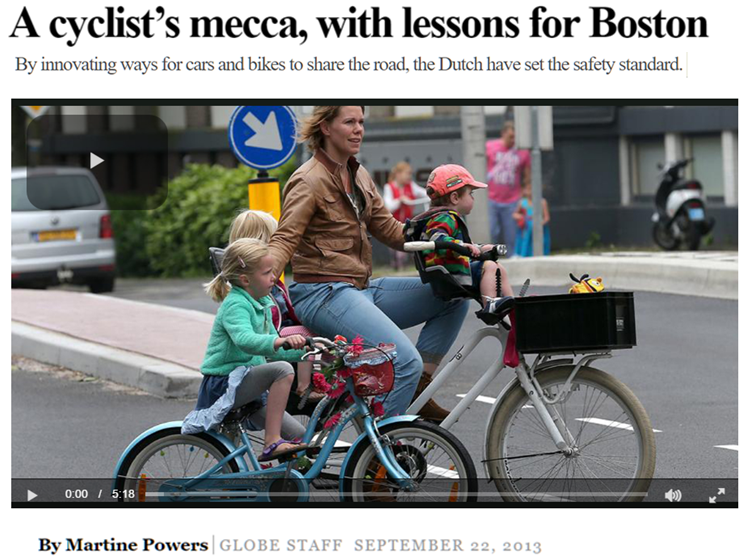
From Boston Globe, Sept. 22, 2013. Video & article available at link if a subscriber.
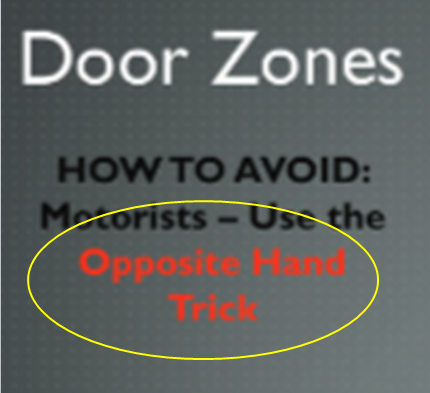
Tip: "HOW TO AVOID:
Motorists - Use this
Opposite Hand Trick. "
Slide is part of FC Bikes' Bicycle Friendly Driver Program training course section on Door Zones and dooring prevention.
2014 (?) FORT COLLINS, CO, USA
Fort Collins, Home of the 'Opposite Hand Trick'!
The City of Fort Collins, Colorado bicycle transportation office, FC Bikes, in coordination with the local advocacy non-profit Fort Collins Bikes developed and began promoting the "Opposite Hand Trick" aka far hand reach method in the mid 2010's.
It is part of FC Bikes/Bike Fort Collns' Bicycle Friendly Driver Program. The BFDP is now being adopted in over 120 towns and cities around the the country.
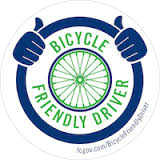
Logo for Fort Collins, CO FC Bikes' Bicycle Friendly Driver Program.
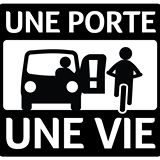
2014 - MONTREAL, CANADA - UNE PORTE UNE VIE
Montreal cycling safety advocates launched a determined anti dooring campaign in April 2014 based on earlier work by Vélo Saint-Zotique and the Montréal Bike Coalition, with the aim to raise awareness, foster behavior change and prompt greater government action on dooring. Bilingually named ‘One Door, One Life’ / ‘Une Porte, Une Vie’ the campaign's name, slogan, signature logo and stickers highlight the hazard of dooring. The campaign itself now has its own website.
Press interviews on the launch date included description of the far hand method, as in this GlobalNews.ca TV report of April 5, 2014. (MBC's original launch announcement is here).
CTV News then cites the method in a May 3, 2014 story focused on cycling safety and the new anti-dooring campaign: Dooring dangers: Cyclists, drivers need to be alert as peak cycle season arrives
A revised Global News video posted a month later
focuses clearly on the far hand method.
However Une Porte, Une Vie outreach and educational materials to specifically teach and promote the method have not been found on their website. [Reader: Please contact to correct me & provide files or links if UDUP does! - ed.]
The far hand method for safer exiting is explained by campaign spokesperson Geoffrey Bush near the very end of the story.
2015 - SAN FRANCISCO VISION ZERO - TWO VIDEOS
SF TRUCK DRIVER VIDEO TEACHES THE ‘REACH’
Large Vehicle Urban Driver Safety 2015 (17 min) – is road sharing safety video produced by San Francisco Municipal Transportation Agency (SFMTA). It was created as part of a larger effort to re-train Bay Area fleet drivers to more safely adjust to the rising tide of cyclists and pedestrians. Dooring risk and the far hand method are explained and shown at 14:30 min.
The City of San Francisco collaborated with the Vision Zero SF coalition in its scripting and production. Its members included SFMTA, San Francisco Bicycle Coalition, Walk SF, Vision Zero SF, & SFGOVTV . SFBC & Walk SF consulted on best practices for high-risk vehicle-bicycle situations. They oroduced twin road sharing safety videos, one for Large Urban Vehicle Drivers, the other for all other Urban Drivers. The LVUDS video is used as part of SFMTA's outreach program to retrain large vehicle fleet drivers across the Bay area.
Urban Driving Safety video - San Francisco Vision Zero
The Dutch far hand method is taught at 12 min 54 sec.(Dec 2015)
2015 - NEW ZEALAND'S OFFICIAL ROAD CODE
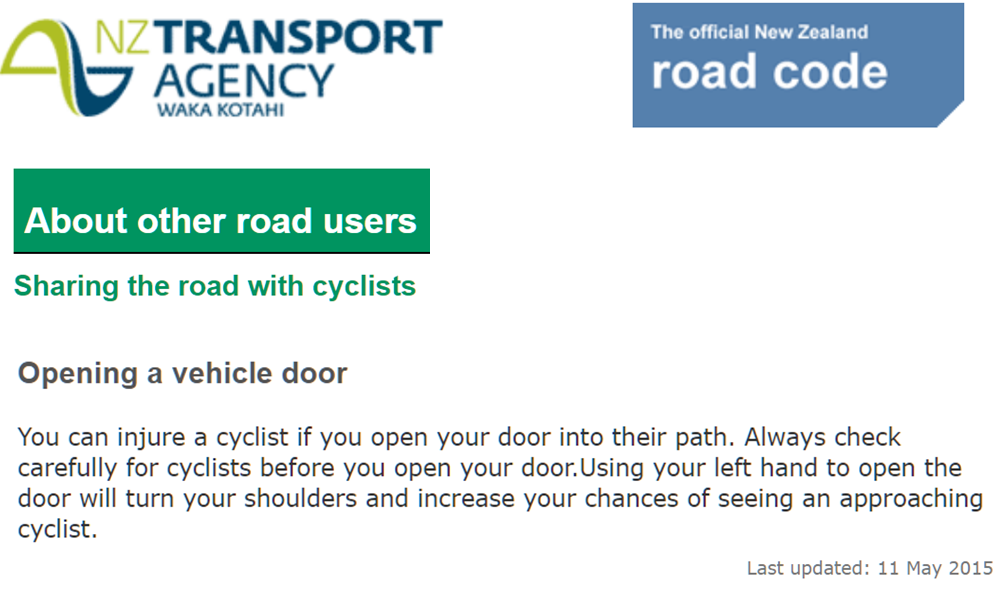
New Zealand Transport Agency, Official Road Code on Opening Vehicle Doors [2015]
2016 - RACV Australia
Car dooring, a worrying trend on the rise
Text in this article well describes the reach method. Yet while the accompanying RACV video calls for motorists to do a shoulder check, the far hand habit is not depicted nor its advantages explained.
Note: By December 2016 doorings remained a major concern in Melbourne, Victoria, AU. It had been the subject of a sticker-based dooring 'awareness' campaign, a behavioral field study and a mapping study which resulted in targeted infrastructure improvements. The field study of such 'awareness' stickers concluded they were ineffective at the moment of egress. On this, see: Reducing 'car dooring' The role of stickers as visual reminders. Final Report. Ipsos Social Research, 2013. Prepared for Road Safety Action Group, Melbourne, AU.
'DUTCH REACH' TERM FIRST WENT PUBLIC SEPTEMBER 7, 2016

Mobile electronic traffic sign first 'texted' the Dutch Reach. Somerville, Mass., USA, 7 Sept 2016. Sign triggered media coverage which led to international attention. Credit: Dutch Reach Project.
'DUTCH REACH' TERM & PROJECT'S FIRST PRINT APPEARANCE
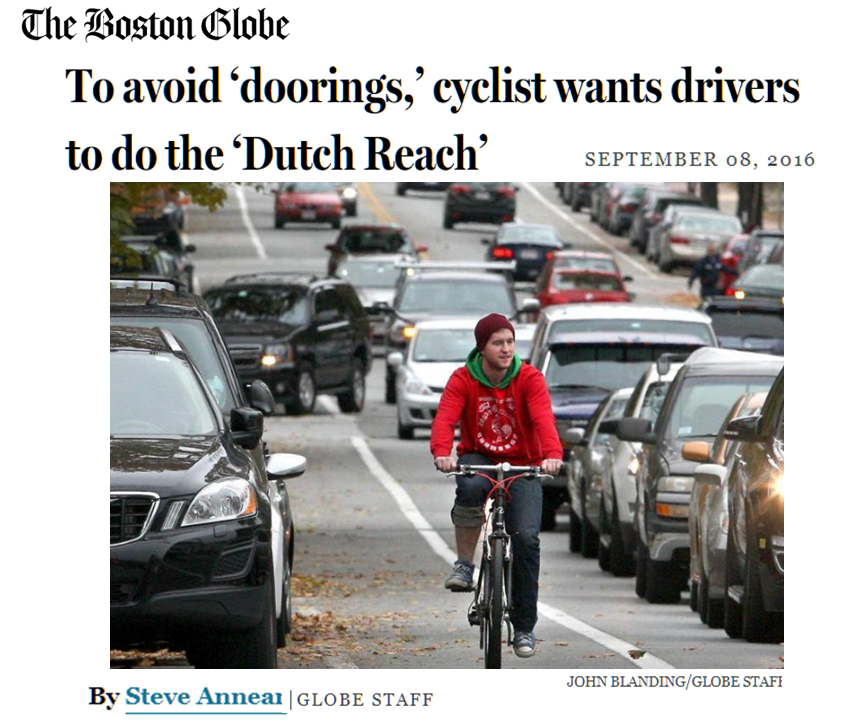
Boston Globe 9 Sept 2016: First print story about the Dutch Reach campaign, by Steve Annear, Globe Staff reporter. Click image for article.
BREAK OUT!!! OUTSIDE ONLINE'S DUTCH REACH VIDEO - 2016:
September 19, 2016
THE DUTCH REACH - SAFE FOR WORK
THE SIMPLE TECHNIQUE THAT COULD SAVE CYCLISTS’ LIVES
It's called the Dutch Reach, and if a Massachusetts doctor has his way, it could prevent road riders from ever getting doored again
By: Ben Fox Sep 19, 2016, Outside Magazine Online
Outside's “How the Dutch Reach Could Save Lives” video went viral within days of posting on its home site and YouTube. As of August 3, 2017 it had logged over 2.5 million views worldwide on Outside's accounts only! Untold untallied viewings have occurred on other websites also carrying the video, some dubbed or translated with captions. Google Dutch Reach Videos for examples or see Foreign Videos under Resources drop down menu box above.
2015: DUTCH DRIVING INSTRUCTION VIDEO DEMO’S THE REACH
SAFE VEHICLE EXITING LESSON -
A driver's education video from The Netherlands, in Dutch!
For this video with English translation transcript, go here. Note: This Uitstappenuit de auto teaching video by Rijleshulp.nl was posted onYouTube May 29, 2015. However this method is reported to be the recommended best practice among many Netherlands' driving schools and instructors for decades.
*For this video with English translation transcript, go here!
FAR HAND METHOD in THE NETHERLANDS
For documentation of the Far Hand Method's introduction & practice in The Netherlands, see: Is the ‘Reach’ Method Really Dutch?
Shoulder Check Poster, RoSPA, UK. 1950'
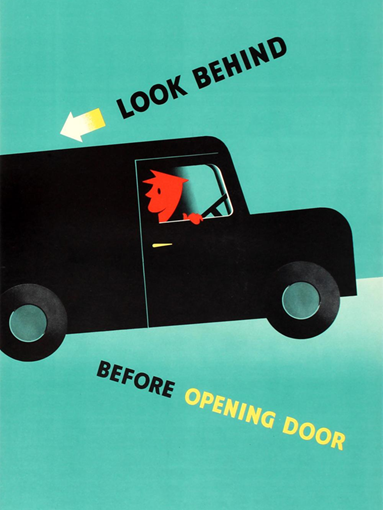
Look Behind Before Opening Door, road safety poster by Leonard Cusden, for the Royal Society for the Prevention of Accidents (UK), 1950, Note the apparent use of the far hand to assist driver's pivot. Post by Safer Essex Roads Partnership June 11, 2020, here.
